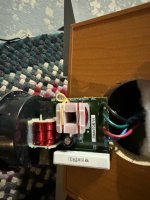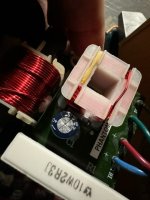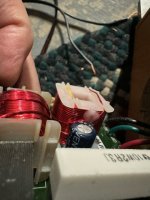Hi Everyone,
I am new to the forum and not sure if this is the good topic for the group or not, if not just let me know. I have been reading a lot about how upgrading crossover components can improve speaker sound. I have a collection of old to newer speakers that I would be interested in doing this to. So to start I'd like to get my feet wet with a old set of Paradigm Phantom V4 speakers as an experiment. They are in great shape and I use them in my basement workshop. Better sound is always good, learning about crossovers and how to do it would be even better at this point.
Here are the specs I could pull together
3-driver, 2-way bass reflex, quasi-3rd-order resistive port
High-Frequency Driver : 25mm (1in) CMC™ ceramic/metal composite dome
Two 165mm (6-1/2in) MPC™ metallescent cones, GRIP™ chasis
Frequency Response : 49Hz - 20kHz, +/- 2dB (on-axis) 49Hz - 18kHz, +/- 2dB (off-axis)
91dB / 88dB
15 - 160 watts
8 ohms
The crossover is pretty basic. One electrolytic cap (4uF 100 V), 1 resistor (10 W 2.2 Ohms - I think) and two induction coils (no information). For experience I'd like to replace all the parts. I have two questions. 1) can I use a 4.7 uF 100V cap instead of 4 uF (could not find a 4uF film cap) and 2) what do I get for induction coils? There are no identification markings. Crossover pics attached.
Thanks in advance and if not appropriate just let me know. Best,
I am new to the forum and not sure if this is the good topic for the group or not, if not just let me know. I have been reading a lot about how upgrading crossover components can improve speaker sound. I have a collection of old to newer speakers that I would be interested in doing this to. So to start I'd like to get my feet wet with a old set of Paradigm Phantom V4 speakers as an experiment. They are in great shape and I use them in my basement workshop. Better sound is always good, learning about crossovers and how to do it would be even better at this point.
Here are the specs I could pull together
3-driver, 2-way bass reflex, quasi-3rd-order resistive port
High-Frequency Driver : 25mm (1in) CMC™ ceramic/metal composite dome
Two 165mm (6-1/2in) MPC™ metallescent cones, GRIP™ chasis
Frequency Response : 49Hz - 20kHz, +/- 2dB (on-axis) 49Hz - 18kHz, +/- 2dB (off-axis)
91dB / 88dB
15 - 160 watts
8 ohms
The crossover is pretty basic. One electrolytic cap (4uF 100 V), 1 resistor (10 W 2.2 Ohms - I think) and two induction coils (no information). For experience I'd like to replace all the parts. I have two questions. 1) can I use a 4.7 uF 100V cap instead of 4 uF (could not find a 4uF film cap) and 2) what do I get for induction coils? There are no identification markings. Crossover pics attached.
Thanks in advance and if not appropriate just let me know. Best,
Attachments
First just replace the capacitor. That's what will make the difference.
You could use a 3.3uF film in parallel with a 0.68uF. But there may not be room.
Those are custom made inductors.
Moved to multi way.
You could use a 3.3uF film in parallel with a 0.68uF. But there may not be room.
Those are custom made inductors.
Moved to multi way.
The way to make a difference with a crossover is to improve the blend of acoustic characteristics you're crossing. If you identify issues they may even benefit most from acoustic fixes.
Use 4uF capacitor instead of 4.7uF capacitor and keep all the original inductors if you want your speakers sound the same. Replacing resistor with 10W metal oxide resistor may improve sound from tweeter (metal oxide resistors are best for high frequencies).
Thanks for the reply. There might be room depending on the size of the capacitor. Ill do some homework. I would wire these in series, correct? A 3uF and 1uF or 2uF and 2uF, would also work, in principle, correct? A am familiar with Parts Express. Who are the other suppliers to check out?First just replace the capacitor. That's what will make the difference.
You could use a 3.3uF film in parallel with a 0.68uF. But there may not be room.
Those are custom made inductors.
Moved to multi way.
For experience I'd like to replace all the parts.
The only parts I'd consider replacing here are the caps and resistors. To replace inductors correctly you need to measure the inductance and DCR. I recommend Dayton DATS. It can also help you in ensuring you match ESR in older electrolytics but honestly they look fine as is.
For resistors, for fun, try Mills. Inexpensive, small, very stable and non-inductive as a start. Normally I recommend Mundorf MKP caps as a starter cap for those getting into the field. You'll notice no difference, or you will and you won't have spent much, but I don't think they are available in the value you need.
If you really want to get into this as a hobby, it's worth considering getting DATS as well as starting to use XSim to simulate your existing crossover. What they will help you do together is get a complete electrical simulation of your original speaker behavior, as well as accurately measure caps and coils and see how the changes you might perform (lower DCR inductors for instance) will affect the output.
Erik thank you for sharing your experience. DATS and software makes sense to simulate output changes from modified parts. In your experience or from your knowledge of others how well do the simulations compare to actual measurements?
Mundorf does not have the cap you mentioned at the correct value so I will get the Dayton metalized caps mentioned above. Parts Express also has Theta film and foil at the right value but are $64 ea as compared to $1.50 for the Daytons. Worth it?
Mundorf does not have the cap you mentioned at the correct value so I will get the Dayton metalized caps mentioned above. Parts Express also has Theta film and foil at the right value but are $64 ea as compared to $1.50 for the Daytons. Worth it?
Some do think Thetas are worth the price; I'm on the fence at this end (on principle I like film & foil construction). That said: if you must, have you thought of simply using a 3.9uF cap? It's a perfectly standard value from most manufacturers, and well within any kind of tolerance you could reasonably expect given the filter / general speaker design.
This loudspeaker seems to be falling in the group of "better leave alone and exchange like-for-like".
Thank you for your thoughts. I was wondering whether a 3.9 might work. If there is 5%-10% +/- tolerance then 3.9 and 4 may be statistically be the same depending on sample distribution. However, I am new to this so as a first step I will test like for like. My goal with these speakers is just learn and get experience before moving on to others speakers I own. If I get improved sound then its a bonus. I am going to buy DATS gear as well so I can better understand the changes I am making.Some do think Thetas are worth the price; I'm on the fence at this end (on principle I like film & foil construction). That said: if you must, have you thought of simply using a 3.9uF cap? It's a perfectly standard value from most manufacturers, and well within any kind of tolerance you could reasonably expect given the filter / general speaker design.
I would wire these in series, correct? A 3uF and 1uF or 2uF and 2uF, would also work, in principle, correct?
Note for future reference: Capacitance adds when capacitors are connected in parallel with each other.
- Home
- Loudspeakers
- Multi-Way
- Paradigm Phantom V4 Crossover Upgrade


